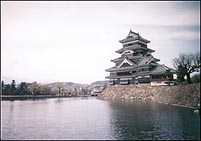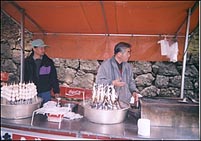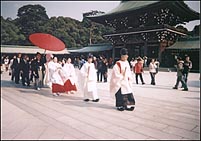Helen Rose: Hill Diary April 2003
Japan: A walk on Miyajima
 I have had an interest in Japan as a friend was invalided there from the War in Korea and had spoken of how beautiful the island of Miyajima is. It is considered by the Japanese to be one of the three most beautiful places in Japan. Over the years I have intended to visit the island but I decided this year to make the trip and combine it with a fairly comprehensive tour of Japan. I looked through the trip profiles of the various adventure companies and found a tour that included Miyajima. This particular tour offered all the places I was interested in and included stays in different types of accommodation.
I have had an interest in Japan as a friend was invalided there from the War in Korea and had spoken of how beautiful the island of Miyajima is. It is considered by the Japanese to be one of the three most beautiful places in Japan. Over the years I have intended to visit the island but I decided this year to make the trip and combine it with a fairly comprehensive tour of Japan. I looked through the trip profiles of the various adventure companies and found a tour that included Miyajima. This particular tour offered all the places I was interested in and included stays in different types of accommodation.

We stayed in a mixture of a accommodation , from small hotels to traditional Ryokans and Minshukas, where we slept on futons in traditional screened rooms with tatami mats and where shoes were removed at the front door and ucatta gowns were worn indoors. As far as possible, I tried Japanese food , which is great if you like seafood and noodles. The raw fish was delicious and very tender. Travel was mainly by smooth Shinkansen trains with speeds of up to 280 kilometres per hour. The average time for trains being late was 4 minutes over the year for the whole of Japan but those I travelled on were punctual to the second!
 Now for some details on Miyajima. The island is located in the Inland Sea off the coast form Hiroshima and is descrbed in all tourist literature as a place for rest and relaxation. It is only a short boat trip from the outskirts of Hirishima and the first sight seen is the red Otori Gate standing in the sea as it was high tide. This is when the gate is most imposing as the temples are framed behind it on the island. Unfortunately, the Otori Gate was covered in scaffolding as it was time for maintenance but there are very good photographs of it in the various travel books.
Now for some details on Miyajima. The island is located in the Inland Sea off the coast form Hiroshima and is descrbed in all tourist literature as a place for rest and relaxation. It is only a short boat trip from the outskirts of Hirishima and the first sight seen is the red Otori Gate standing in the sea as it was high tide. This is when the gate is most imposing as the temples are framed behind it on the island. Unfortunately, the Otori Gate was covered in scaffolding as it was time for maintenance but there are very good photographs of it in the various travel books.
On arrival at the pier we looked around the village and walked up to the Komcyin Temple and then the Itsukushima Shrine, which is on a wooden walkway on the edge of the sea. The island is a favourite for day trips by the Japanese and it is important to arrive early before it gets very crowded in the afternoon.
The island is home to a large deer and monkey population. The deer are wild and have some religious significance in Buddhism so are not hunted. They are small and very friendly but always on the lookout for food and will steal it from children when given the opportunity. Due to limited time, we travelled to the top of Mount Misen by cable car or Ropeway as the Japanese call it. The trip took us from the south to the north of the island over the tree clad hills. In a short time, we reached the Observatory Station about 300 metres above sea level and had a view of the Inland Sea. A further walk up through woods took us to the summit of Mount Misen. The monkeys were busy swinging in the trees and bags had to be closed to avoid losing your belongings to the monkeys with a particular interest in the contents of handbags - such as sunglasses.
 At the top there were various temples and shrines with deities wearing what looked like little embroidered aprons. I am not sure of the significance of these aprons but I would be interested to know what they symbolise. After some rest and relaxation on the summit, we decided to walk down to the pier through the woods which took us around 40 minutes on a very good path. It was a fine warm day so the walk was very enjoyable and we reached the village at the pier in time to enjoy oysters, caught locally, before taking the ferry back to Hiroshima to spend time at the Peace Park and Museum.
At the top there were various temples and shrines with deities wearing what looked like little embroidered aprons. I am not sure of the significance of these aprons but I would be interested to know what they symbolise. After some rest and relaxation on the summit, we decided to walk down to the pier through the woods which took us around 40 minutes on a very good path. It was a fine warm day so the walk was very enjoyable and we reached the village at the pier in time to enjoy oysters, caught locally, before taking the ferry back to Hiroshima to spend time at the Peace Park and Museum.
There are many shrines and temples on the island but time did not allow me to investigate further. I would be interested in hearing from anyone who has visited Miyajima both recently and in the 1950s.
Contact me at [email protected]/
Thanks to Frances Rickus for the photographs.







